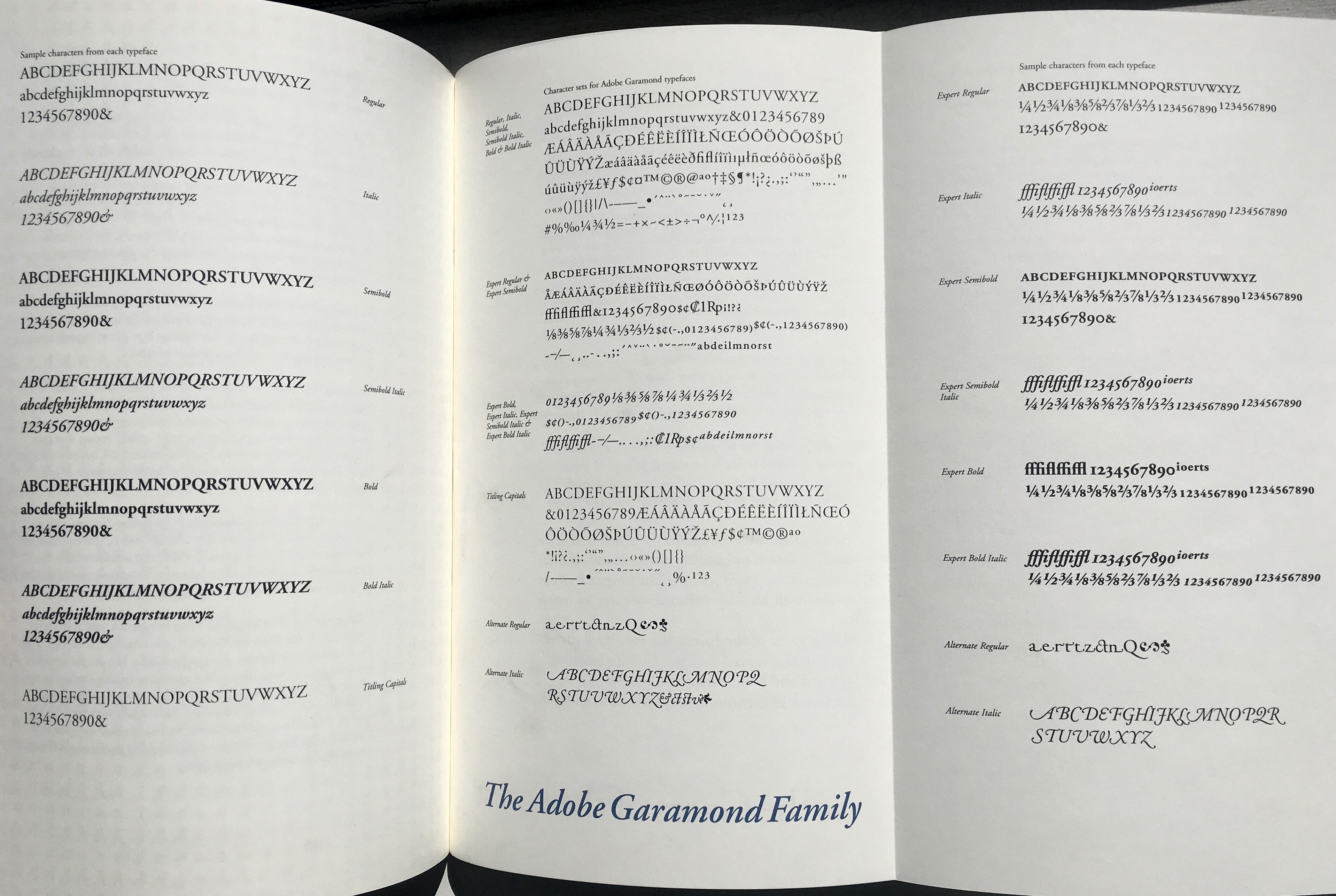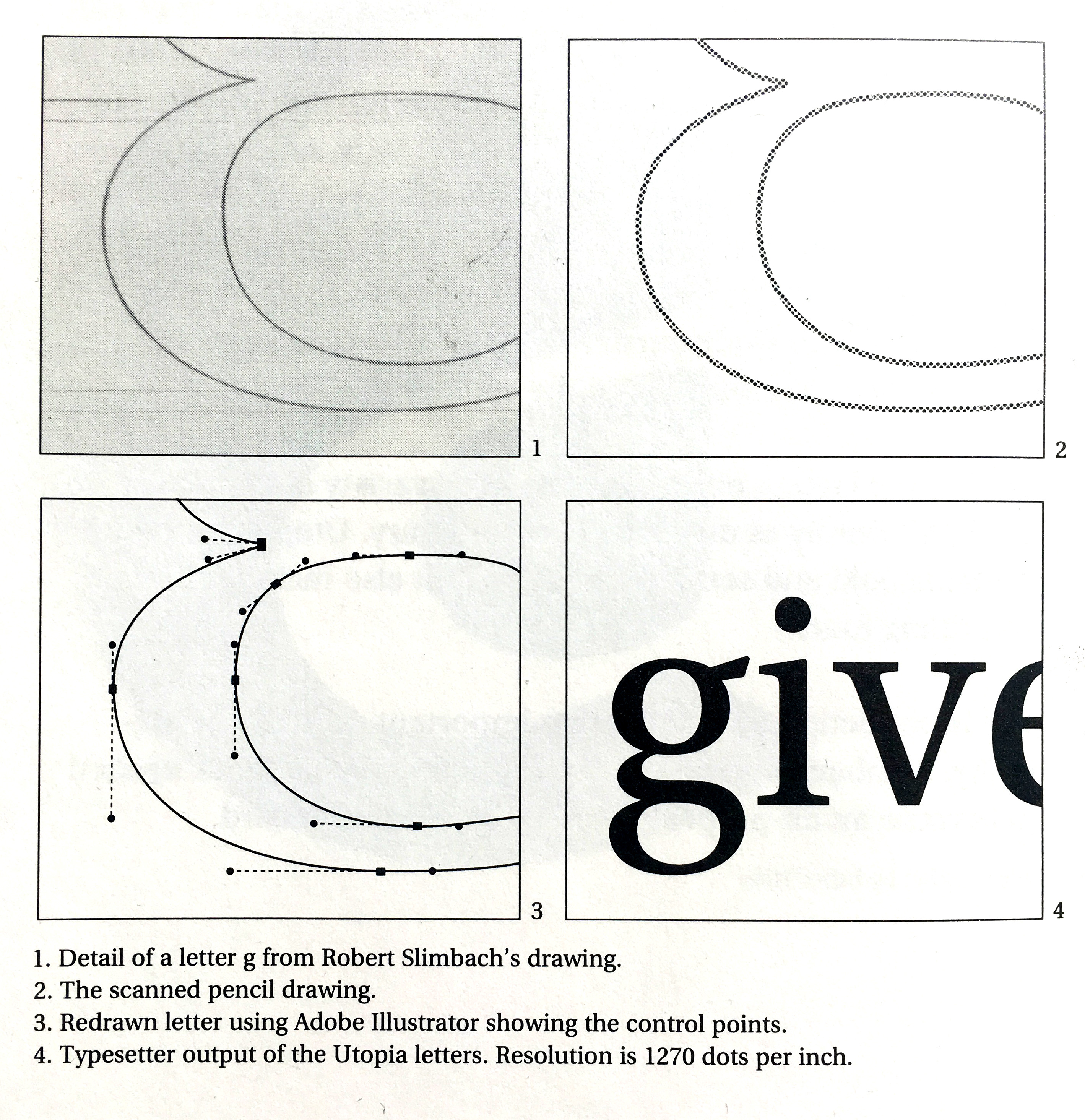A Look Back: Adobe Type & 30 Years of Illustrator
It’s fitting to talk about Adobe Illustrator’s 30th anniversary with two people who have been the bedrock of the Adobe Type team for the last 30 years: our Principal Type Designer Robert Slimbach, who celebrated his 30th anniversary at Adobe at the start of this month, and David Lemon, who retired last month after being with Adobe Type for just over 30 years as well.

The specimen for Adobe Garamond (released in 1989) shows the broad scope of the family, which is not unusual for an Adobe Original typeface. Adobe Illustrator changed the way typefaces like this were produced in-house.
Illustrator’s arrival changed the way designers worked inside Adobe, and both Robert and David experienced this first-hand.
“When Robert and I started at Adobe there was no serious desktop publishing software,” said David. “To do anything interesting, one had to write PostScript. The only way to make an attractive type specimen was to code it, so I did. It took me several days of futzing.”
When the first version of Illustrator came out, David was somewhat hesitant to embrace it. “It was clearly just a GUI on top of PostScript, and I wasn’t sure artists would find it worth learning.”
It didn’t take long for him to warm to the software, though. “The drawing behavior was different from the various font tools I’d experienced, but it opened new possibilities. I soon cut short my budding PostScript programming career, and went on to use Illustrator for publication design work. For some time all my specimens were created in Illustrator.”
Illustrator wasn’t intended to be a type design tool, but it quickly became a bridge for designers who wanted to more naturally draw letterforms before refining and developing the fonts themselves in a UNIX-based CAD tool called FE that ran on SunOS 3.
Robert had worked on similar UNIX systems before coming to Adobe, and was keenly aware of the technical hurdles they posed. “You couldn’t digitize in this UNIX system, which forced you to adjust outlines by typing in the coordinates,” he said. “You’d want it to be fairly realized before you brought into UNIX, because you couldn’t do any editing that involved a lot of shape manipulation. It wasn’t very intuitive to use. This is why a small Latin-only font seemed like a huge project. It was so painstaking.”

This figure from the specimen for Robert Slimbach’s Utopia (also released in 1989) explains the process made possible by Illustrator’s easy-to-use drawing tools.
Illustrator allowed Robert to bring the act of drawing more directly into his type design process. “It only took a few minutes to learn to draw in Illustrator and miraculously it produced a nice curve. The ease with which you could refine shapes was really wonderful.” The technology simplified his workflow considerably as well: “You’d scan in a drawing, trace it with the pen tool in Illustrator, then import it into UNIX.”
Illustrator’s blend feature — which calculates the intermediate shape between two different selected objects — also made it possible to think about typefaces as masters for interpolating intermediate weights or styles. Right from the start, Illustrator allowed the type team not just to restore typographic features to older designs that were compromised during the phototype era, but immediately add something new to the idea of what a family was.
When did you first start using programs like Illustrator in your work? Whether it was also 30 years ago, or more like 30 minutes, we’d love to hear your take. Join the Illustrator 30th celebration over on the Creative Cloud blog — and stay tuned for more from us, too.
7 Responses
Comments are closed.
I was born in 1950, and got my start with fonts in grade school by creating and hand lettering posters for school events. I took mechanical drawing as an elective class in junior high and learned more about lettering then. Later in high school, I cut letters out of redwood with a router for a sign. My first professional job using Adobe Illustrator was to make a perspective line drawing of a mechanical component which an engineer had designed for a manufacturing company in Chicago. I later did a ton of work for a college textbook publisher drawing literally thousands of graphs and diagrams for their books. I loved Illustrator for its clean precision, flexibility, and ease of use. I let me have so much more fun drawing and lettering with getting my hands dirty! Today, after 30 years, Illustrator is the best it’s ever been, and there’s still no end in sight for me!
It was 1997 I srarted using adobe illustrator. and feel comfort to use it.
I can say only illustrator is the app for designers, no any other options at all…
I started using Illustrator around 1997. At first it seemed totally unintuitive, especially coming from a Photoshop background, and the interface itself was intimidating. But once I began to realize the precision possible by “drawing” with coordinates and curves, it was like a lightbulb went off. Illustrator was the answer to my logo-creating dreams. Version 9 was my workhorse for many years. I eventually stuck with Illy CS6 (because I refuse to submit to Adobe’s greed, er, subscription model. I prefer to own the program, not “rent” it.)
Ditto on owning, not renting.
I was introduced to Illustrator in college, just a few years ago. I had worked in PS, but was self-taught, and didn’t know a whole lot.
I would like to learn more about Illustrator so I can make my own digital, and for-print scrapbook elements, but, I’m really having trouble learning how to make curves. I’m not dyslexic, but feel like it when I’m trying to draw with the pen tool, making curves. LOL
Hello, I was “forced” to Illustrator after the Adobe’s FreeHand slaughter… 🙂
I have dreamed they mix the Illustrator’s power with the friendliness and intuitivity of FH way and instruments, but this never happened.
Another Adobe’s mistake is not haveing standardized the keyboard commands for all CS’s softwares…
Adobe Illustrator became a primary tool in my design beginning in 1990. In its 30 years, it has become a key force in the development of modern graphic design. As a designer, typographer, and illustrator—It is my right hand… and with keyboard shortcuts, it’s my left hand too.
I’ve been a graphic designer since the 70s. In 91 I made the transition to the Mac. By that time, my specialty was packaging design; big boxes of pots and pans and the other housewares you’d find in department stores. At fist, I made my designs in Quark Xpress, for some stupid reason, and just used Illustrator for logos. But soon I realized that Illustrator was so much more powerful than what I was using it for. It was like taking the film off my eyes. The way it worked was like it was showing me the real thing, instead of it being hidden away under a child’s interface. What’s important about Illustrator is that it’s resolution-independant. Many designers use Photoshop for large-size work like packaging, and wind up with gigabyte files. Illustrator files could be enlarged to the size if the Grand Canyon and still be of manageable size.